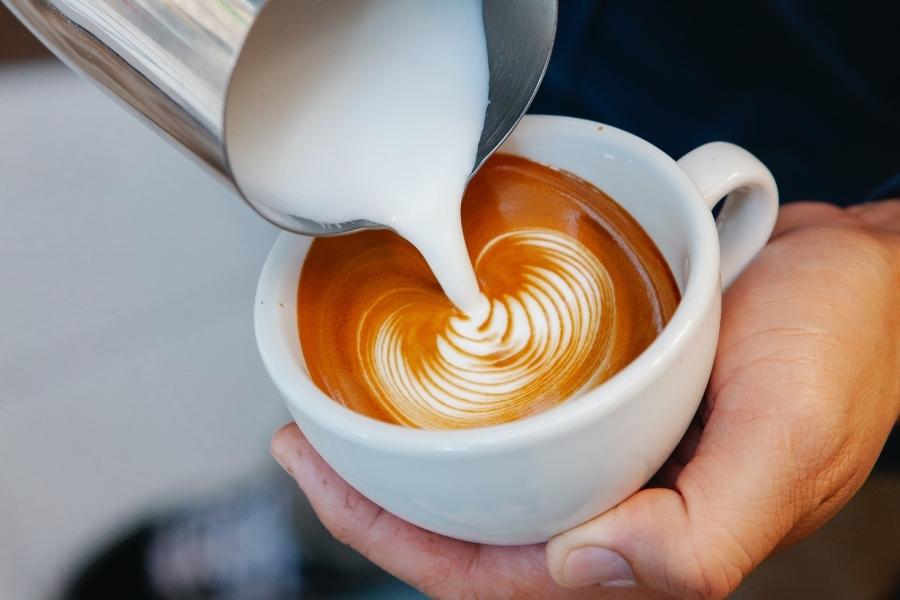Your run-of-the-mill cappuccino will usually have equal parts of espresso shots, steamed milk, and microform. However, you can also have a wet or dry cappuccino depending on how the amount of milk and foam changes. So, what’s the difference between wet foam vs dry foam cappuccino? Let’s find out.
Contents
Wet Foam vs Dry Foam Cappuccino General Overview
First of all, a cappuccino is a type of coffee that is made with espresso shots, steamed milk, and microform. However, the ratio of milk and form can be changed to create a wet or dry cappuccino.
What’s the difference? Let’s look at a quick overview of each type.

Wet Foam Cappuccino
A wet foam cappuccino is made with more steamed milk and less microform. This results in a drink that is less bitter and has a creamier texture.
You will get the same size cup as a regular cappuccino. However, because there is more milk in the drink, it will be less concentrated. As a result, you might find a wet foam cappuccino very similar to a regular latte.
This is a favorite of coffee drinkers who want a sweet but laid-back taste. The increased amount of milk mellows out the coffee bitterness to give a sweet and creamy drink with just the right hint of caffeine.
Dry Foam Cappuccino
A dry foam cappuccino is made with less steamed milk and more microform. This way you get a drink that is more bitter and has a frothier texture.
Even though there is less milk in the drink, the foam will make it appear fuller. You might even get a little less cappuccino than you would if you ordered a wet foam or regular cappuccino. This cappuccino usually takes longer to make since you will need to froth the milk first.
There is also another variation of a dry foam cappuccino known as a bone dry cappuccino. This is a cappuccino that is made with no steamed milk whatsoever. Instead, it is just espresso shots and microform.
Comparing Wet Foam Cappuccino and Dry Foam Cappuccino
Now that you have an idea of what each type of cappuccino is, let’s do a more in-depth comparison of wet foam vs dry foam cappuccino.
Similarities Between Dry and Wet Cappuccino
Despite the differences in the ratios of ingredients, there are some similarities between wet foam and dry foam cappuccino. Let’s look at how the two are similar.
Both Have Equal Amounts of Espresso Shots
Although the milk to foam ratio usually changes, both dry and wet cappuccinos will have the same amount of espresso shots. This is because the amount of espresso used to make a cappuccino is generally standardized. You will usually find that a cappuccino has 6 ounces of espresso.
Of course, this can vary depending on the café you go to. However, the amount of espresso is generally not changed to create a wet or dry cappuccino.
Both Use the Same Size Cup
Although the ratios of the ingredients might be different, both wet foam and dry foam cappuccino will be served in the same size cup. This is because the finished product will have roughly the same volume, regardless of the amount of milk or foam used.
The idea is to vary the taste and creaminess, not the volume.
Differences Between Dry and Wet Cappuccinos
Wet foam and dry foam cappuccino often differ in terms of:
- Amount of milk
- Amount of microform
- Taste
- Texture
- Appearance
Amount of Milk
Wet foam cappuccinos use more steamed milk and less microform, while dry foam cappuccinos use less steamed milk and more microform. This difference in the amount of milk will change the taste, texture, and appearance of the cappuccino.
Amount of Microform
Since wet foam cappuccinos use more milk and less microform, dry foam cappuccinos have the opposite ratio. Dry foam cappuccinos will have more microform and less milk. This also changes the taste, texture, and appearance of the drink.

Taste
The taste of a cappuccino is largely affected by the amount of milk used. Wet foam cappuccinos are generally less bitter because they have more milk. This dilutes the espresso and creates a creamier flavor.
On the other hand, dry foam cappuccinos are stronger with a bitter taste. This is because there is less milk to dilute the espresso. The amount of microform can also affect the taste of a cappuccino. More microform with less milk often results in a drink that is more bitter and less sweet.
Texture
Texture simply refers to the consistency of the cappuccino. Wet foam cappuccinos are generally creamier because of the higher milk to microform ratio. Dry foam cappuccinos, on the other hand, are frothier because of the higher microform to milk ratio.
Appearance
The appearance of a cappuccino is also affected by the ingredients used. Wet foam cappuccinos generally have a creamier appearance because of the higher milk to microform ratio. Dry foam cappuccinos, on the other hand, often appear fuller because of the higher microform to milk ratio.
A wet foam cappuccino might also come with some art on top, whereas a dry foam cappuccino generally will not. This is because it is easier to create art on milk than on foam.
Major Distinguishing Factor
The main distinguishing factor between a wet and dry cappuccino is the amount of milk and microfoam used.
Wet foam cappuccinos use more milk and less microform, while dry foam cappuccinos use more microform and less milk. This difference in ratios of ingredients changes the taste, texture, and appearance of the cappuccino.
When to Use Wet Foam Cappuccino
- Wet foam cappuccinos are best when you want a creamier, less bitter drink.
- The higher milk to microform ratio results in a cappuccino that is creamier and has a more dilute espresso flavor.
- Wet foam cappuccino is also a good option if you are looking to spruce up your drink with some latte art. The milk is easier to work with than foam.
When to Use Dry Foam Cappuccino
- If you prefer a frothier cappuccino with a stronger espresso flavor, then dry foam cappuccino is the way to go.
- Since there is more microform than milk, you will get a drink that is fuller and has a more concentrated espresso flavor.
If you love the texture of foam on your mustache, you will enjoy this particular cappuccino.
Which Cappuccino Is Better?
At the end of the day, there is no right or wrong answer when it comes to wet foam vs dry foam cappuccino. It all comes down to personal preference.
Do you prefer a creamier drink with less espresso flavor? If so, go for a wet foam cappuccino. Do you like your cappuccino frothy with a strong espresso flavor? You will enjoy a glass of dry foam cappuccino. No matter which type of cappuccino you choose, you are sure to enjoy the rich flavors and creamy texture.
Final Verdict
Now, you should be able to easily pick your favorite cappuccino the next time you visit Starbucks. When it comes down to it, the main difference is the amount of milk and microform used. Wet foam cappuccinos use more milk and less microform, while dry foam cappuccinos use more microform and less milk.



